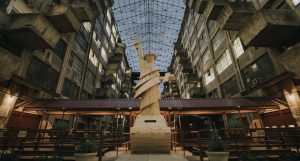“Doomocracy”:
- A form of government in which the supreme power is vested in a tyrant by a terrified general electorate.
- The esoteric arithmetic that makes the electoral process malleable.
- A corporate coup d’état in slow motion.
- Permanent global war waged in the name of freedom.
This text is stamped on the flyer delivered at the entrance of Doomoracy, the latest project commissioned by the New York art organization Creative Time. For this intervention Mexican artist Pedro Reyes was invited to interact with the Brooklyn Army Terminal, a 97-acre site in Sunset Park that once was the United States’ largest military supply. Now, more than a base, the site resembles a very lucid and very bad dream. Projects like Palas Por Pistolas (Shovels for Guns) have made Reyes famous. For this installation he asked the citizens of Culiacán—a Mexican city with a high rate of gun violence—to turn in their guns. The metal of the handed-in-weapons was melted and eventually transformed into shovels used to plant trees. Reyes is widely recognized for his communitarian interests and his civic engagement
PHOTO CREDIT: Will Star/Shooting Star Pro Courtesy of Creative Time
On entering the military-industrial and brutalist construction, myself and the other spectators find a hollowed-out version of the Statue of Liberty. The sculpture is made out of plywood, immediately bringing in images of Odysseus’ Trojan horse. The metaphor is explicit. The forcible export of U.S-branded freedom and democracy is portrayed with all its blatant deceptiveness. The audience hears a carefully-constructed and easily palatable battle cry in which individual’s lives and livelihoods are obscurely used to advance corporate interests. The position of the artists’ vis-à-vis this manipulation is crystalized.
In small groups, we are then directed into a van where a right-wing political radio resound as the vehicle advances. In the middle of its course, the van is flagged by military police in SWAT gear and its passengers are asked—in standard dash-cam harassment lingo—to step out. The police snatch the doors of the van open and force the passengers inside a dimly lit building—ghostly and forgotten. A light is flashed into my eye. “Are you an American citizen?” they shout as they push me into a dark wall, my arms over my head. I shyly mutter the word “No.” But no one hears me. Instead they ask: “are you carrying any drugs with you?” They force me into a line as they yell “do not move! Keep your hands up!” Because I am an immigrant, I was especially struck by this. It felt a little too close to home—a little too real. It made the performance’s beginning particularly powerful and poignant. I only wish this uncomfortable and unsettling feeling would have accompanied me throughout the entire piece.
After this, Reyes has us in for a treat; a downward spiral of the current state of affairs in the form of short skits that follow performers from one room into another. Political fraud, financial corruption, fast-food industry, educational systems, gun control, abortion, the business of death, the politics of art and a near future where air is sold “at a very reasonable price.” In other words, the gangs all here! One of the highlights of this series of mis-en-scènes is the macabre funeral. In this scene, a decadent man is sitting in front of an organ. The most bizarre funeral of all times takes place around him. The viewer is confronted with a Twinkie-shaped coffin placed in the middle of a room decorated with poorly hung drapes of cheap velvet. The organist sings in a husky, jazzy and seductive voice: “I’d like to think that in the afterlife, kids can taste their coffins and they’re happy.” While he sings, he offers the audience a variety of coffins: a doughnut shaped coffin, a chicken-winged coffin, a coffin that looks like fries and, many others. 
PHOTO CREDIT: Will Star/Shooting Star Pro Courtesy of Creative Time
Another highlight is the reproduction of a 1970’s suburban home. Upon entering, three fabulous housewives greet the viewer. They are eager to welcome the audience into their community. Yet they also warn it against the recent delinquencies the community has experienced. They say: “It’s just, like, you know how there are certain demographics that are more prone to committing crimes than others.” They showcase their seasonal attires and their matching guns, because “we woman are alone and unprotetcted all day in our homes.”
Related Article: “IMPAKTER POETRY WITH LILY BLACKSELL“
These recurring scenes, however were a little too lite. Doomocracy felt as if Reyes wanted to display the viewers to every single problem that neoliberal frameworks have constructed for our future, but in doing so, the satire felt a little too under the nose, a little too obvious, a little too easy. Maybe even redundant. Rather than unpacking these problems and their concomitant fears to the viewers and presenting a real critique of them, he merely delineated and exhibited them. I cannot help but wonder what would have happened if this performance had been staged in a small town in Wyoming. The self-selecting audience that Creative Time summons already agrees with most of Reyes’ points –if not all of them. But what if this piece were to exist somewhere else? What would happen? Would its effect be more powerful?
PHOTO CREDIT: Will Star/Shooting Star Pro Courtesy of Creative Time
The most terrifying part of it all were not the singing cheerleaders or the armed housewives, but my docile complaisance in the performance. For most of the time, I wanted to turn around and ignore the instructions I was given. I wanted to object to the actors, to shout at their offending comments in outrage. But I didn’t. Neither did the other viewers. We were merely the spectators of the absurd; watching and accepting a world as it disintegrated before our eyes. Maybe we laughed –a little nervously—because we realized we didn’t need Reyes or his jokes anymore. We have been submerged in the irrational world he depicts for a while now. However, if we don’t address these conflicts more diligently, as the title of this project suggests, we are to become a doomed society. It reminds me of a scene in Douglas Adams’ “The Hitchhikers Guide to the Galaxy”—when Ford is asked who governs his country, he responds: “On this world, the people are people. The leaders are lizards. The people hate the lizards and the lizards rule the people.” And his friend Arthur replies “Odd, I thought you said it was a democracy.” “I did,” concludes Ford. “It is.”
Doomocracy closes two days before US presidential elections, the day American society will truly decide just how doomed democracy, the US and the future of our planet is.
Recommended Reading: “BREATHING NEW LIFE INTO OLD BOOKS WITH BRIAN DETTMER“











